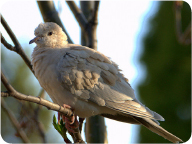 Ringed Turtle Dove
Ringed Turtle Dove
Streptopelia risoria
Description
The Ringed Turtle Dove is gray in color with a darker gray back and a slightly lighter head and chest. There is a black band around the nape of the neck. Its eyes are dark red in color. Males and females are similar in appearance.
Size
Adults are 10-11 inches in length, with a wingspan of about 20 inches. They weigh 4 to 6 ounces.
Adaptations
- Birds have many adaptations that make them well adapted for flight, including feathers and hollow bones that decrease their weight.
- Ringed Turtle Doves are extremely swift, and can fly at 45-50 mph. They also have the ability to quickly change direction during flight.
- Doves and pigeons have amazing navigation abilities. There are magnetic tissues in their heads that help them to detect the earth’s magnetic field and determine direction.
Diet
The diet of Ringed Turtle Doves consists of seeds, grains, and fruit. They have become accustomed to eating seeds provided by humans, and in many cases have become dependent on that food source. At Cosley Zoo, the dove is fed mealworms, insects, fruits and vegetables, and birdseed.
Reproduction
Ringed Turtle Doves mate for life and lay eggs several times each year. Females will lay 1 or 2 eggs per clutch (group of eggs). Both parents will incubate the eggs for 13 or 14 days, until they hatch. The young leave the nest about 2 weeks after hatching.
Shelter and Space Needs
Ringed Turtle Doves are non-native to Illinois. Wild populations have originated from birds that were released by pet owners or escaped. These groups of birds usually live in wooded areas, often near the humans that they rely on for food.
Life Expectancy
Captive Ringed Turtle Doves can live up to 20 years.
Importance to Man
Doves symbolize peace, and are often released during weddings. Ringed Turtle Doves are kept as pets throughout the world, and are sometimes used by magicians. In nature, these birds help to disperse seeds.
Fun Facts
- The Ringed Turtle Dove is able to drink by sucking water up into its beak. Many birds do not have this ability, and therefore have to tip their heads back to drink.
- The male Ringed Turtle Dove collects the sticks to build the nest. After bringing them to the nest site, he gives them to the female, who arranges them into the proper position.
- The terms “dove” and “pigeon” are often used interchangeably.
- Because of their navigational abilities, doves and pigeons used to be used as messengers, especially during times of war.





